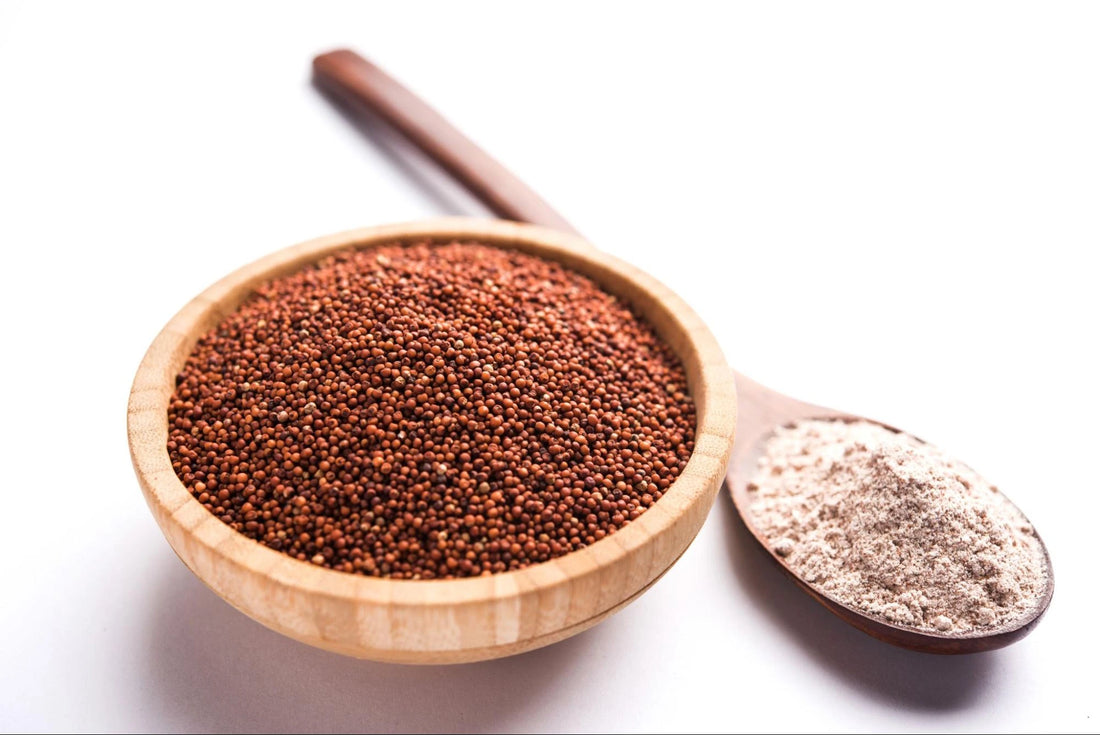
Health Benefits of Finger Millet: Its Nutritional Profile & Uses
Share
Filler Millet or Ragi or Nachni is one of the earliest cultivated cereals in India and is back to being popular again, thanks to its elevated status as the “super food”. A superfood is something that offers multi-faceted nutritional benefits and ragi does just that. From months old babies to the elderly, this is a true crowd pleaser and can be turned into a multitude of dishes, something for everyone. In this blog, we'll explore the health benefits of finger millet, its nutritional profile and uses.
What is Finger Millet?
Before diving into finger millet health benefits let’s quickly go through the history of the grain. Belonging to a grass family, Poaceae, finger millet (Eleusine coracana) grows in the high-altitude regions of Africa and Asia.The byproduct of this crop, the seeds, are essentially the millet. Ragi can be found in various colors like red, brown, yellow, tan, violet, and white but the red variety is commonly cultivated.
Did you know that India is the largest producer of this gluten-free grain in the world?
Nutritional Profile of Finger Millet
|
Nutrition per 100g
|
|
|
Energy
|
328 KCal
|
|
Protein
|
7.3 g
|
|
Carbohydrate
|
72 g
|
|
Crude Fiber
|
2.6 g
|
|
Calcium
|
344 mg
|
|
Iron
|
8.9 mg
|
Finger millet has the most amount of calcium content across cereals and has three times the level of calcium than milk for the same volume.
Top Health Benefits of Finger Millet
Apart from the above nutritional properties finger millet provides various health benefits which include:
- Aids in Digestion: Due to their high fiber content, they aid in f=digestion and relieve constipation.
- Manages Diabetes: Ragi has phytochemicals in it which slow down the digestion process. This in turn leads to a low glycemic response after consumption making it a great choice of grain for diabetics and also for anyone who wants to avoid sharp sugar spikes.
- Supports Bone Health: As seen above finger millet has a high calcium content which is especially essential for women, children, and old people.
- Anti-aging benefits: Similar to other millets, ragi also has polyphenols and can contribute to antioxidant properties, an important factor for anti-aging.
- Heart Health : Low cholesterol and high fiber make it an apt food option to fight against cardiovascular diseases.
- Aids Weight Management: Due to its low fat content, finger millet is often recommended by nutritionists in the diet plan for people with obesity and for anyone in general who wants to manage their weight.
- Substitute for glutinous grains: People with gluten intolerance or celiac disease can use ragi as a substitute grain to fulfill their nutritional requirement.
Finger Millet Benefits for Hair
With crucial elements needed for hair growth like iron, and zinc, intake of finger millet is beneficial for hair growth and can potentially prevent hair fall. Antioxidant properties of this grain help fight hair loss.
Also Read: Little Millet Health Benefits
How to Use Finger Millet in Your Diet?
Finger millet is mostly incorporated into the diet in the form of its flour.
- Soaked, sprouted and floured ragi can be cooked as a thin porridge and fed to young children to wean off the mother’s milk.
- Ragi flour can be kneaded into rotis and when mixed with other ingredients like urad dal or gram flour can be made into dosas or pancakes.
- In southern states like Karnataka, ‘ragi mudde’, made out of ragi flour and rice, is a summer staple. This can be savored with a variety of gravies.
- Ragi flakes can be made out of flour and can be used as a quick breakfast option.
- Sweet dishes like payasam, or cakes, can be made out of ragi too, recreating a slightly healthier version of your indulgences.
- Ragi idli, ragi vermicelli, ragi puttu, and ragi dhokla are some of the regional variations of the traditional dishes that can be prepared.

How much ragi is too much ragi?
- While consuming ragi is highly beneficial for health, too much of it can cause minor issues like bloating due to high fiber in the millet.
- Further it is not recommended to people with kidney issues due to the presence of oxalic acid.
- Ragi is goitrogenic and can interfere with the regular functioning of the thyroid gland. So people with thyroid-related issues should consume this in regulation.
FAQs about Finger Millet
- What are the health benefits of finger millet?
- Can finger millet be eaten daily?
- Does finger millet have side effects?
- Is finger millet good for weight loss?
- How can I incorporate finger millet in my diet?
With ample benefits ranging from a healthy heart to strong bones and hair, one cannot miss out on including ragi as a pantry staple. Whether you are looking to manage your weight or improve your nutrition intake, ragi fits easily into your daily routine. Go ahead and bring ragi into your life today for a better tomorrow.
Liked this article? Follow our other blogs for awesome and healthy millet recipes and benefits!
Check out our range of gluten free, healthy millet delights here.
